Biosynthesis of Zinc Oxide Nanoparticles Using Leaf Extract of Prosopis juliflora as Potential Photocatalyst for the Treatment of Paper Mill Effluent
Abstract
:1. Introduction
2. Materials and Methods
2.1. Preparation of P. juliflora Extract
2.2. Synthesis of the Targeted Zinc Oxide Nanoparticles
2.3. Characterization of the Synthesized Zinc-Based Nano Particles
2.3.1. X-ray Diffraction (XRD)
2.3.2. Fourier-Transform Infrared Spectroscopy (FT-IR)
2.3.3. Transmission Electron Microscopy (TEM)
2.3.4. SEM Analysis
2.3.5. Energy-Dispersive X-ray Spectroscopy
2.4. Photocatalytic Experiments
2.5. The Reusability of ZnO NPs
2.6. Statistical Analysis
3. Results and Discussion
3.1. XRD
3.2. Structure Refinements
3.3. SEM Study and Nanoparticle
3.4. TEM Study and Nanoparticle
3.5. The Crystal Structure of Hexagonal Wurtzite ZnO NPs
3.6. FTIR Study
3.7. Photocatalytic Studies
3.7.1. The Effect of Catalyst Dosage
3.7.2. ZnO NPs Structure and Reflux Time Effects
3.7.3. Reusability Performance of ZnO NPs in Removal Efficiency of COD in Paper Mill Effluent
4. Conclusions
Author Contributions
Funding
Institutional Review Board Statement
Informed Consent Statement
Data Availability Statement
Acknowledgments
Conflicts of Interest
References
- Garcia-Segura, S.; Ocon, J.D.; Chong, M.N. Electrochemical oxidation remediation of real wastewater effluents—A review. Process Saf. Environ. Prot. 2018, 113, 48–67. [Google Scholar] [CrossRef]
- Hossain, K.; Ismail, N. Bioremediation and detoxification of pulp and paper mill effluent: A review. Res. J. Environ. Toxicol. 2015, 9, 113–134. [Google Scholar] [CrossRef] [Green Version]
- Subramonian, W.; Wu, T.Y.; Chai, S.-P. A comprehensive study on floc characterization and coagulant performance of natural. Ind. Crop. Prod. 2014, 61, 317–324. [Google Scholar] [CrossRef] [Green Version]
- Ashrafi, O.; Yerushalmi, L.; Haghighat, F. Wastewater treatment in the pulp-and-paper industry: A review of treatment processes and the associated greenhouse gas emission. J. Environ. Manag. 2015, 158, 146–157. [Google Scholar] [CrossRef]
- Monte, M.C.; Fuente, E.; Blanco, A.; Negro, C. Waste management from pulp and paper production in the European Union. Waste Manag. 2009, 29, 293–308. [Google Scholar] [CrossRef] [Green Version]
- Särkkä, H.; Bhatnagar, A.; Sillanpää, M. Recent developments of electro-oxidation in water treatment—A review. J. Electroanal. Chem. 2015, 754, 46–56. [Google Scholar] [CrossRef]
- Peterson, H.G.; Hrudey, S.E.; Cantin, I.A.; Perley, T.R.; Kenefick, S.L. Physiological toxicity, cell membrane damage and the release of dissolved organic carbon and geosmin by Aphanizomenon flos-aquae after exposure to water treatment chemicals. Water Res. 1995, 29, 1515–1523. [Google Scholar] [CrossRef]
- Pranjali, G.; Deepa, M.; Nair, A.B. Nanotechnology in waste water treatment: A review. Int. J. ChemTech Res. 2013, 5, 2303–2308. [Google Scholar] [CrossRef]
- Nanomaterials. In Essentials in Nanoscience and Nanotechnology; John Wiley & Sons, Inc.: Hoboken, NJ, USA, 2016; pp. 149–188. [CrossRef]
- Jiang, T.; Liang, Y.; He, Y.; Wang, Q. Activated carbon/NiFe2O4 magnetic composite: A magnetic adsorbent for the adsorption of methyl orange. J. Environ. Chem. Eng. 2015, 3, 1740–1751. [Google Scholar] [CrossRef]
- Serpone, N. Pelizzetti, Ezio, Photocatalysis: Fundamentals and Applications; Wiley: New York, NY, USA, 1989. [Google Scholar]
- Mills, A.; Le Hunte, S. An overview of semiconductor photocatalysis. J. Photochem. Photobiol. A Chem. 1997, 108, 1–35. [Google Scholar] [CrossRef]
- Herlekar, M.; Barve, S.; Kumar, R. Plant-Mediated Green Synthesis of Iron Nanoparticles. J. Nanoparticles 2014, 2014, 1–9. [Google Scholar] [CrossRef] [Green Version]
- Vidya, C.; Hiremath, S.; Chandraprabha, M.N.; Antonyraj, M.L.; Gopal, I.V.; Jain, A.; Bansal, K. Green synthesis of ZnO nanoparticles by Calotropis Gigantea. Int. J. Curr. Eng. Technol. 2013, 1, 118–120. Available online: https://d1wqtxts1xzle7.cloudfront.net/43661237/11-with-cover-page-v2.pdf?Expires=1638518185&Signature=Hvz0a0X5fAheKapHUPeozpG5s6FY0~ksMI~oNLcF4KeJIdYApCveWdkmFr7En69joHG0EpM6yxyX2NvHF9xhKI4R2C8NX9Ebn1OdcekRY5PqKufAN7V6qe~2gKu2CobkPM0u4XPH2NgYTofpWdF3XiP6Xb~GNQvMQdDFJyYc3jKPIam21MyPYZ0XK16iy-sCA4vdcKEHbpsvwNbFsb7-V5hr2OL7oZ2nIyPtHNm5CwcOpq8DjXIdzBPK-8v6N7eetRoN1KCDkyiNVngJDV9Nq7uVHclqzhGrG2A858c1cGUPfCFvHC-vw~awJ1eXS1CsYromI~Jkjr2oMwd5Fv06Bw__&Key-Pair-Id=APKAJLOHF5GGSLRBV4ZA (accessed on 5 November 2021).
- Gnanasangeetha, D.; Thambavani, D. Biological and Physical Sciences Biogenic Production of Zinc Oxide Nanoparticles Using Acalypha Indica. J. Cjemical, Biol. Phys. Sci. 2014, 4, 238–246. [Google Scholar]
- Sindhura, K.S.; Prasad, T.N.V.K.V.; Selvam, P.P.; Hussain, O.M. Synthesis, characterization and evaluation of effect of phytogenic zinc nanoparticles on soil exo-enzymes. Appl. Nanosci. 2014, 4, 819–827. [Google Scholar] [CrossRef] [Green Version]
- Devi, R.; Gayathri, R. Green Synthesis of Zinc Oxide Nanoparticles by using Hibiscus rosa-sinensis. Int. J. Curr. Eng. Technol. 2014, 44, 2444–2446. Available online: https://citeseerx.ist.psu.edu/viewdoc/download?doi=10.1.1.1047.1343&rep=rep1&type=pdf (accessed on 5 November 2021).
- Oudhia, A.; Kulkarni, P.; Sharma, S. Green Synthesis of ZnO Nanotubes for Bioapplications. Int. J. Curr. Eng. Technol. 2005, 1, 280–281. [Google Scholar]
- Srikar, S.K.; Giri, D.D.; Pal, D.B.; Mishra, P.K.; Upadhyay, S.N. Green Synthesis of Silver Nanoparticles: A Review. Green Sustain. Chem. 2016, 6, 34–56. Available online: https://scirp.org/journal/PaperInformation.aspx?PaperID=63969 (accessed on 5 November 2021). [CrossRef] [Green Version]
- Abbas, A.M.; Mancilla-Leytón, J.M.; Castillo, J.M. Can camels disperse seeds of the invasive tree Prosopis juliflora? Weed Res. 2018, 58, 221–228. [Google Scholar] [CrossRef]
- Sawal, R.K.; Ratan, R.; Yadav, S.B.S. Mesquite (Prosopis juliflora) pods as a feed resource for livestock—A review. Asian-Australas. J. Anim. Sci. 2004, 17, 719–725. [Google Scholar] [CrossRef]
- Chaturvedi, O.H.; Sahoo, A. Nutrient utilization and rumen metabolism in sheep fed Prosopis juliflora pods and Cenchrus grass. Springerplus 2013, 2, 1–7. [Google Scholar] [CrossRef] [Green Version]
- Chauhan, A.K.; Kataria, N.; Garg, V.K. Green fabrication of ZnO nanoparticles using Eucalyptus spp. leaves extract and their application in wastewater remediation. Chemosphere 2020, 247, 125803. [Google Scholar] [CrossRef]
- Mostafa, M.; Alrowaili, Z.A.; Rashwan, G.M.; Gerges, M.K. Ferroelectric behavior and spectroscopic properties of La-Modified lead titanate nanoparticles prepared by a sol-gel method. Heliyon 2020, 6, e03389. [Google Scholar] [CrossRef] [PubMed] [Green Version]
- Mobarak, M.; Zied, M.A.; Mostafa, M.; Ashari, M. Effects of growth technique on the microstructure of CuInSe2 ternary semiconductor compound. Heliyon 2020, 6, e03196. [Google Scholar] [CrossRef]
- Momma, K.; Izumi, F. VESTA3 for three-dimensional visualization of crystal, volumetric and morphology data. J. Appl. Crystallogr. 2011, 44, 1272–1276. [Google Scholar] [CrossRef]
- Singh, J.; Verma, N.K. Synthesis and Characterization of Fe-Doped CdSe Nanoparticles as Dilute Magnetic Semiconductor. J. Supercond. Nov. Magn. 2012, 25, 2425–2430. [Google Scholar] [CrossRef]
- Hayat, K.; Gondal, M.A.; Khaled, M.M.; Ahmed, S. Effect of operational key parameters on photocatalytic degradation of phenol using nano nickel oxide synthesized by sol–gel method. J. Mol. Catal. A Chem. 2011, 336, 64–71. [Google Scholar] [CrossRef]
- Tian, G.; Fu, H.; Jing, L.; Xin, B.; Pan, K. Preparation and characterization of stable biphase TiO2 photocatalyst with high crystallinity, large surface area, and enhanced photoactivity. J. Physics. Chem. 2008, 112, 3083–3089. [Google Scholar] [CrossRef]
- Saravanan, R.; Gupta, V.K.; Narayanan, V.; Stephen, A. Comparative study on photocatalytic activity of ZnO prepared by different methods. J. Mol. Liq. 2013, 181, 133–141. [Google Scholar] [CrossRef]
- Rupa, E.J.; Kaliraj, L.; Abid, S.; Yang, D.C.; Jung, S.K. Synthesis of a zinc oxide nanoflower photocatalyst from sea buckthorn fruit for degradation of industrial dyes in wastewater treatment. Nanomaterials 2019, 9, 1692. [Google Scholar] [CrossRef] [PubMed] [Green Version]
- Chauhan, A.; Verma, R.; Kumari, S.; Sharma, A.; Shandilya, P.; Li, X.; Batoo, K.M.; Imran, A.; Kulshrestha, S.; Kumar, R. Photocatalytic dye degradation and antimicrobial activities of Pure and Ag-doped ZnO using Cannabis sativa leaf extract. Sci. Rep. 2020, 12, 1–6. [Google Scholar] [CrossRef]
- Tsoumachidou, S.; Velegraki, T.; Antoniadis, A.; Poulios, I. Greywater as a sustainable water source: A photocatalytic treatment technology under artificial and solar illumination. J. Environ. Manag. 2017, 195, 232–241. [Google Scholar] [CrossRef] [PubMed]
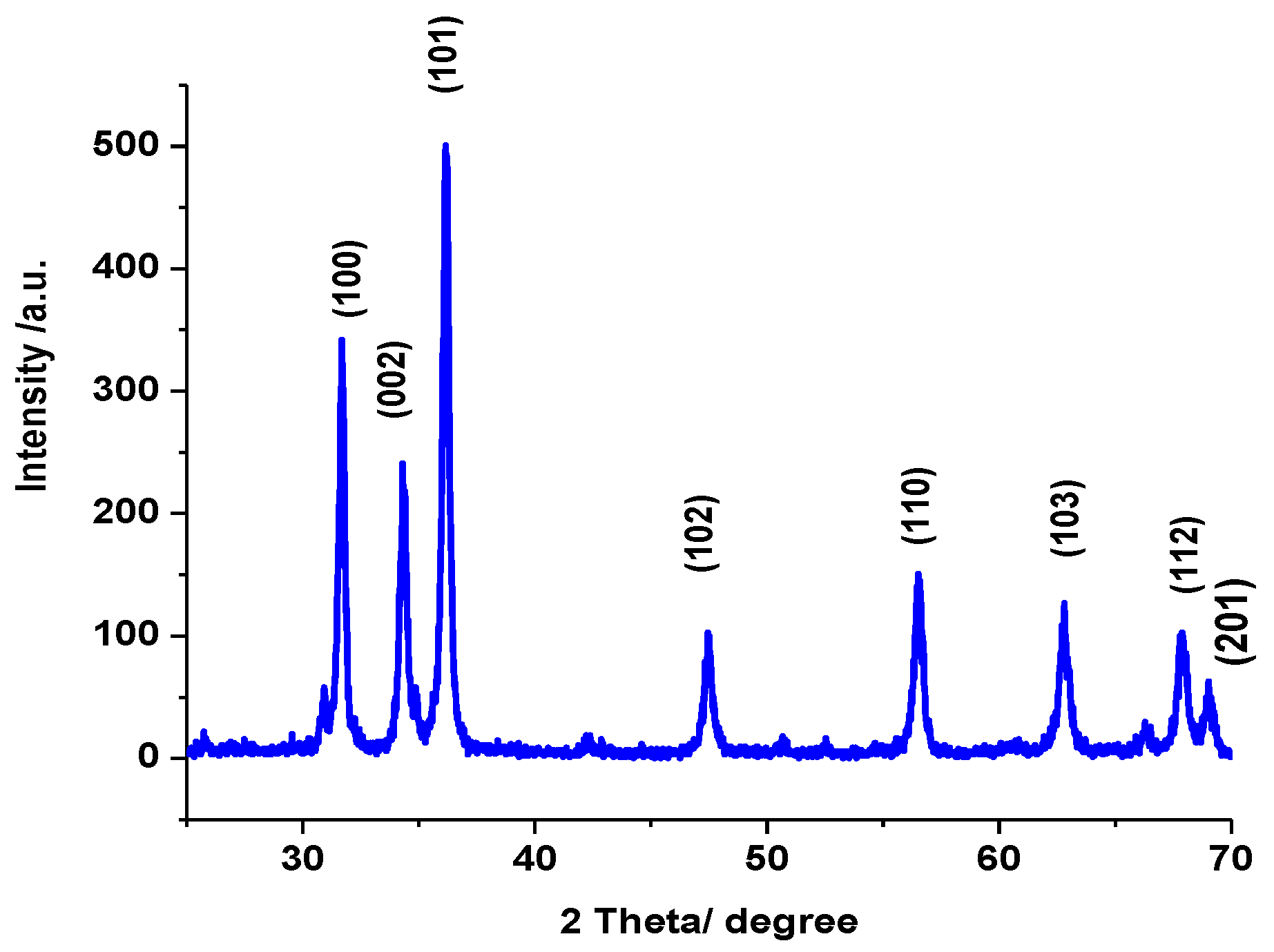

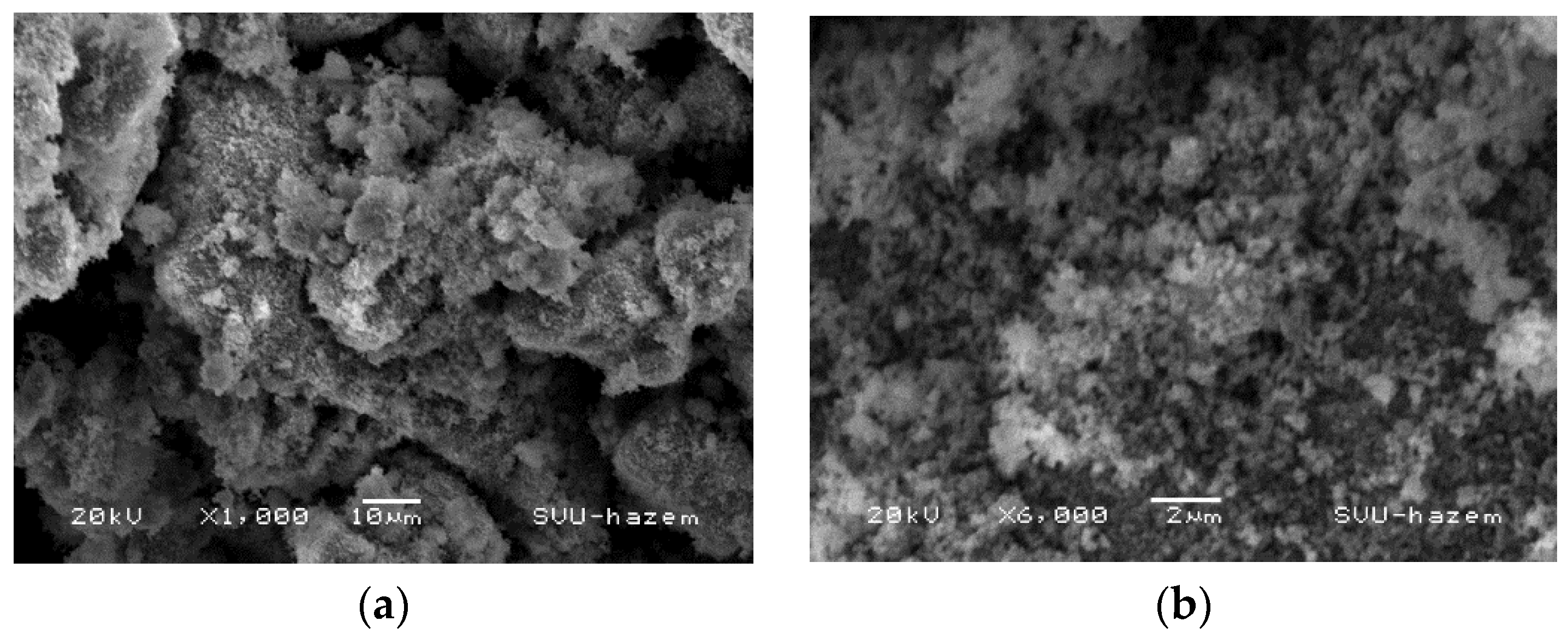
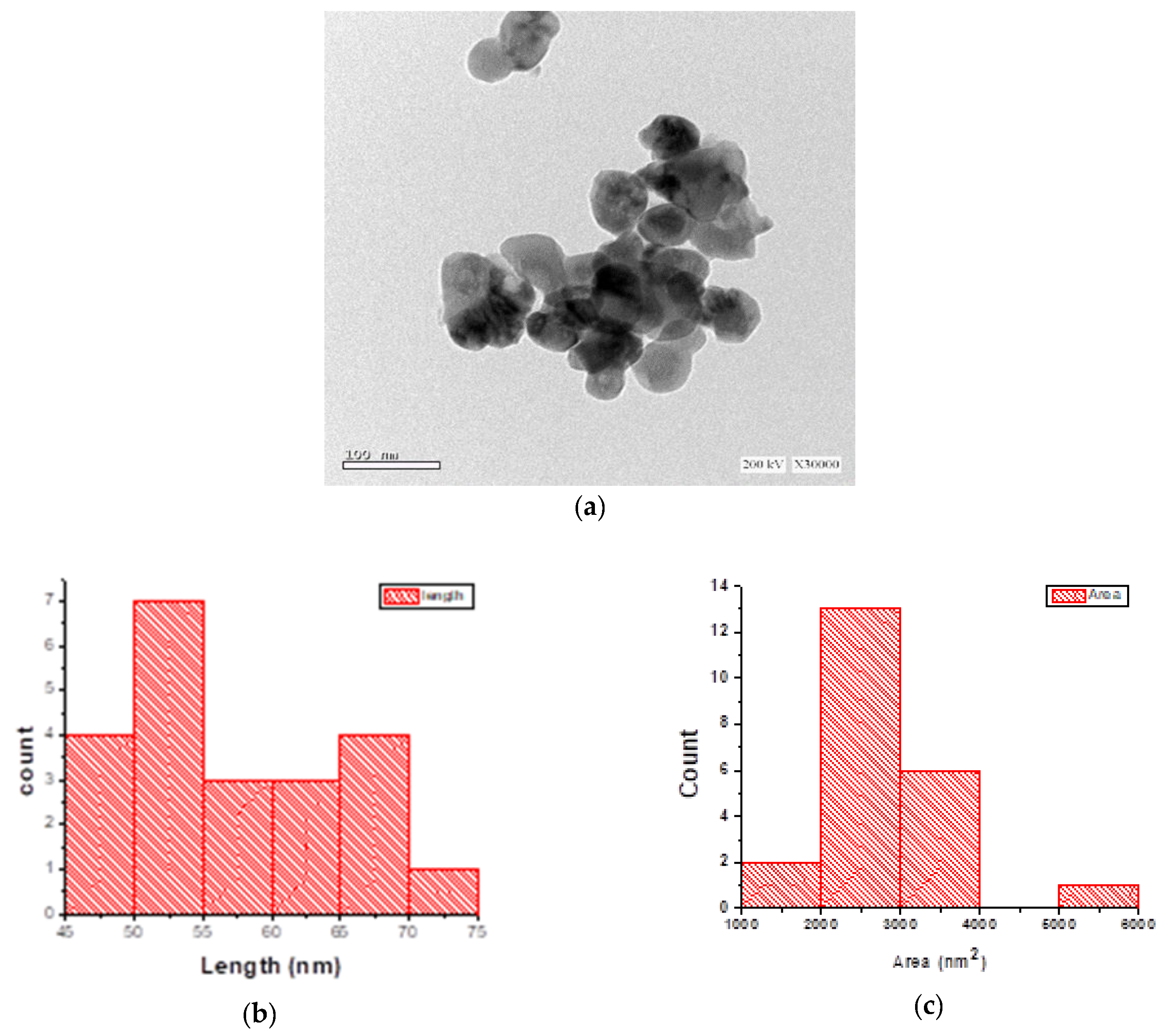
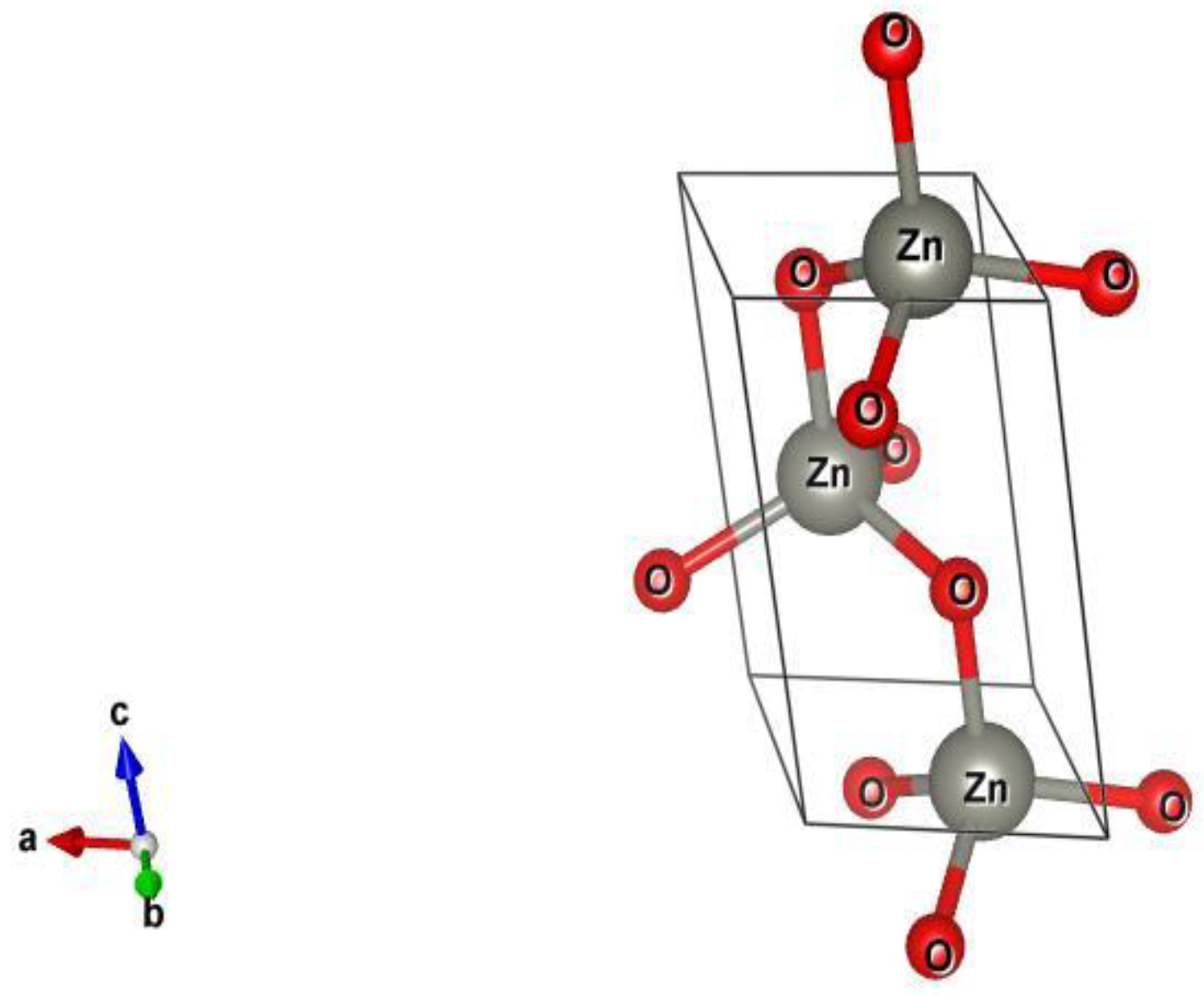
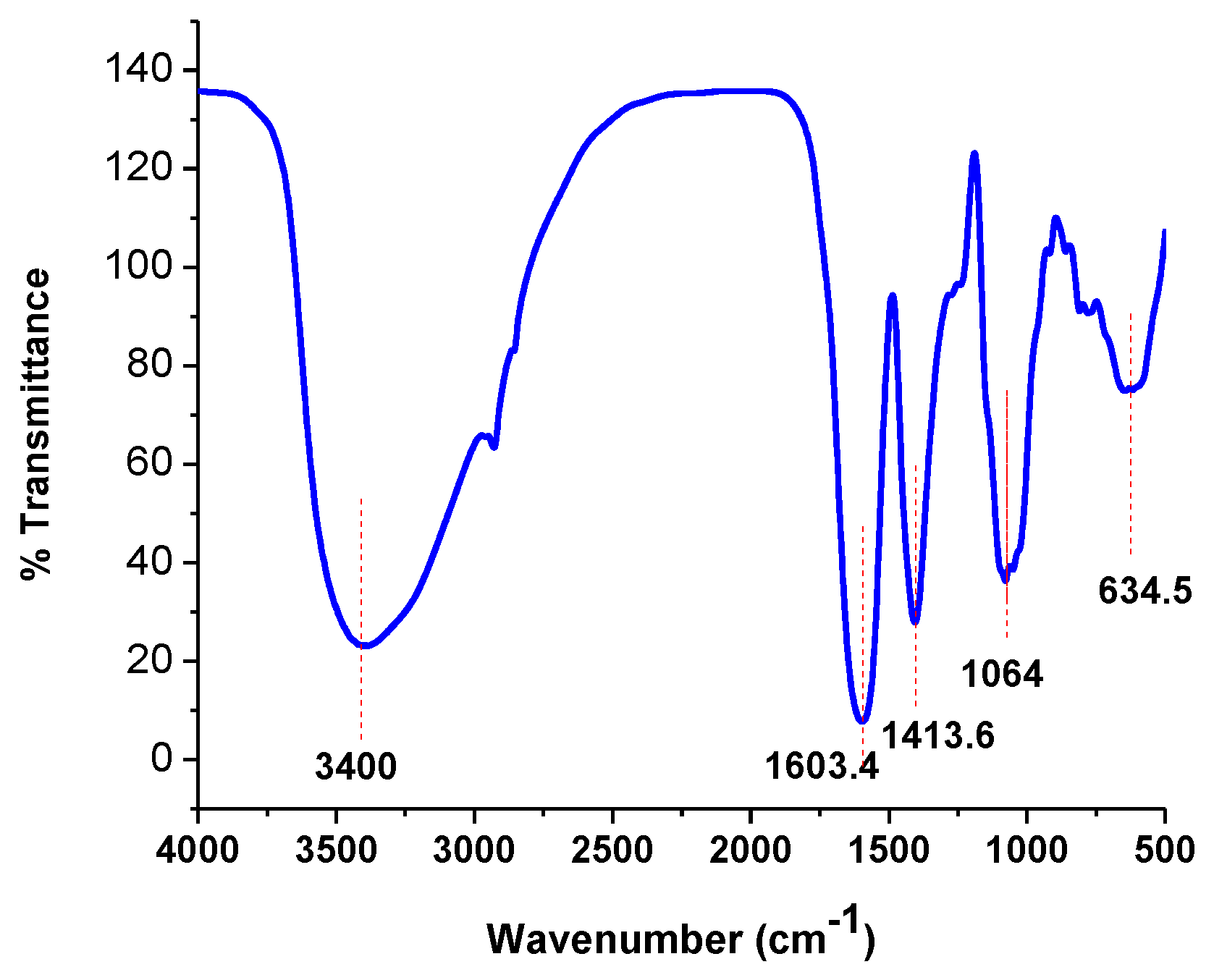
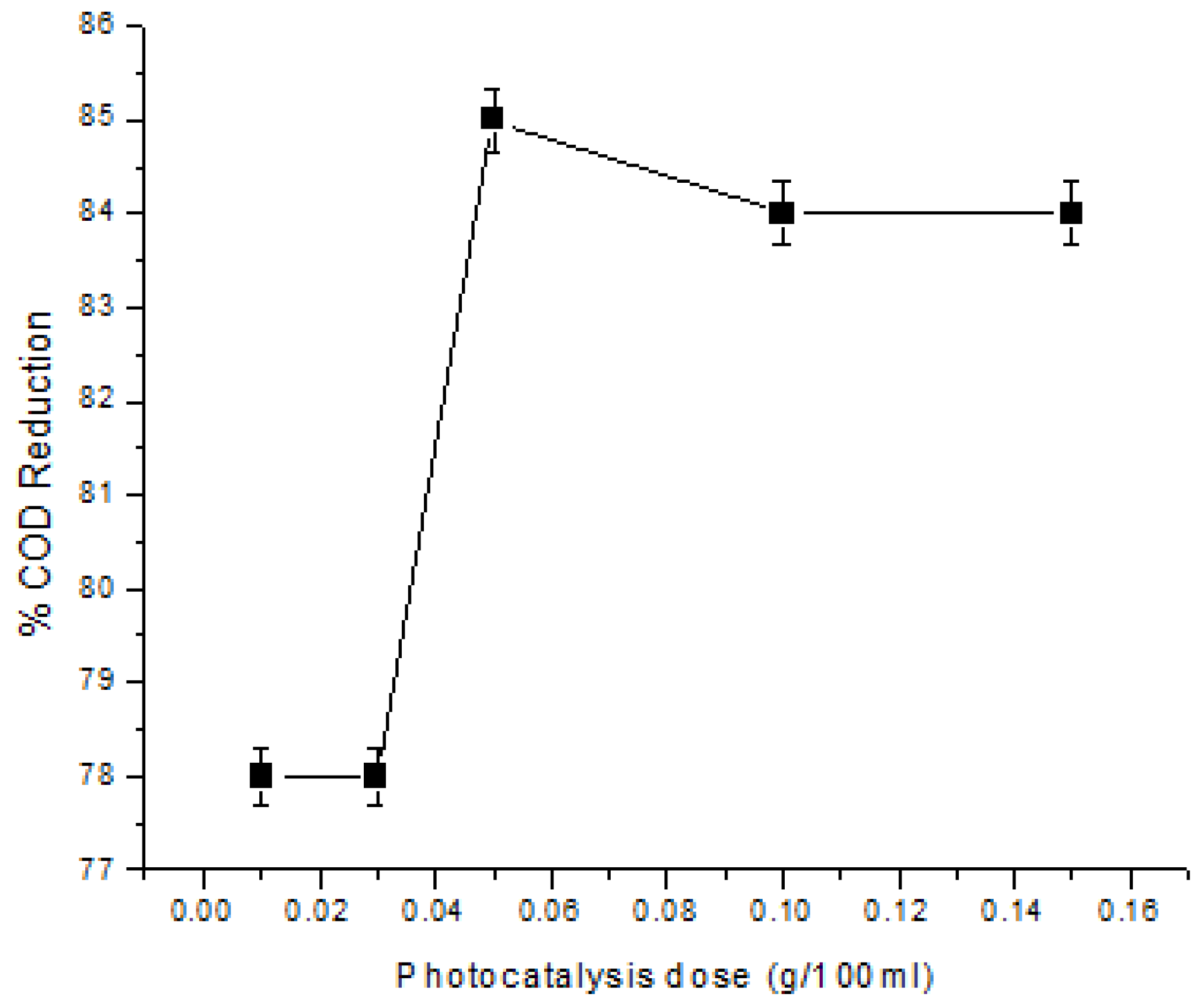
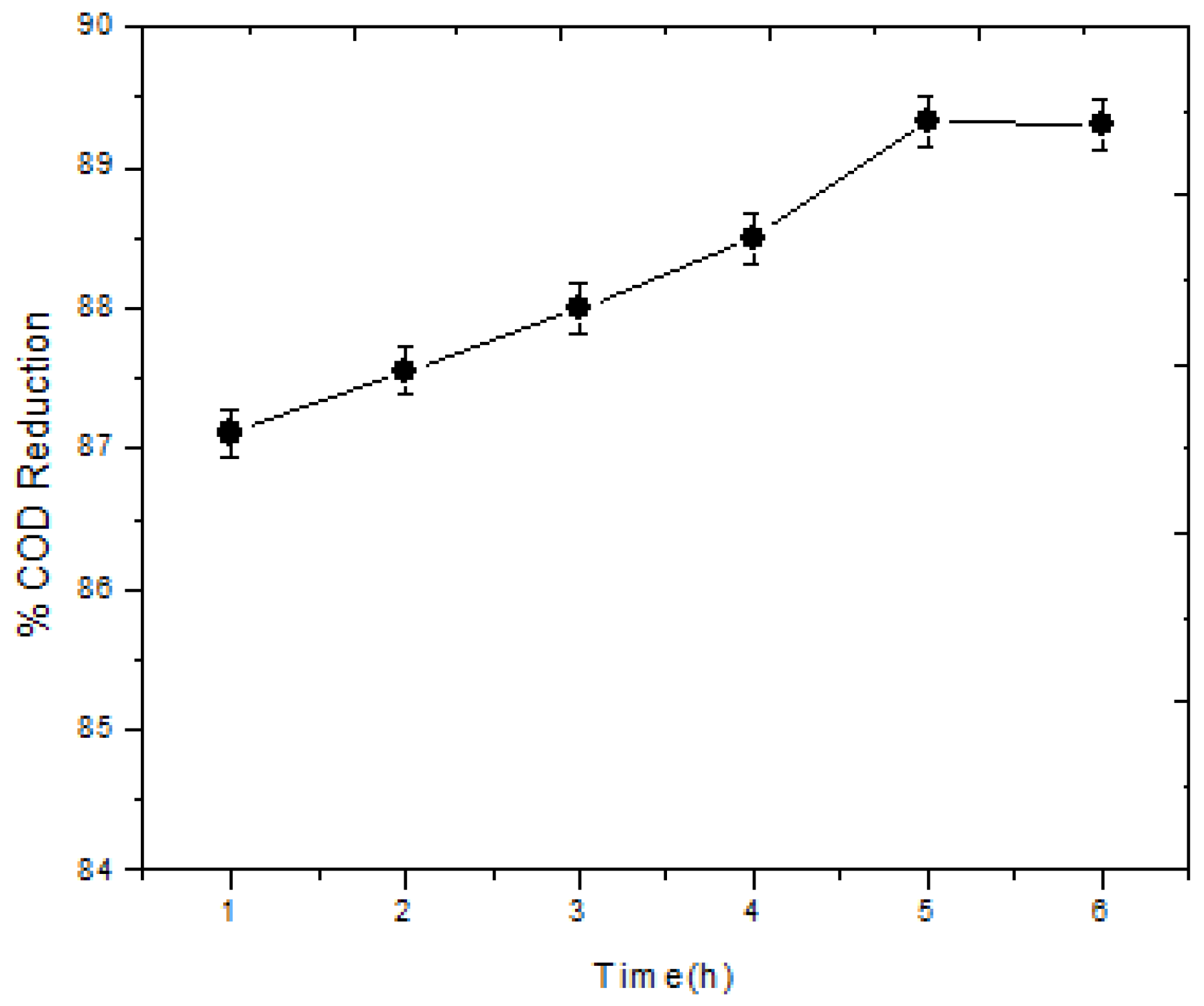
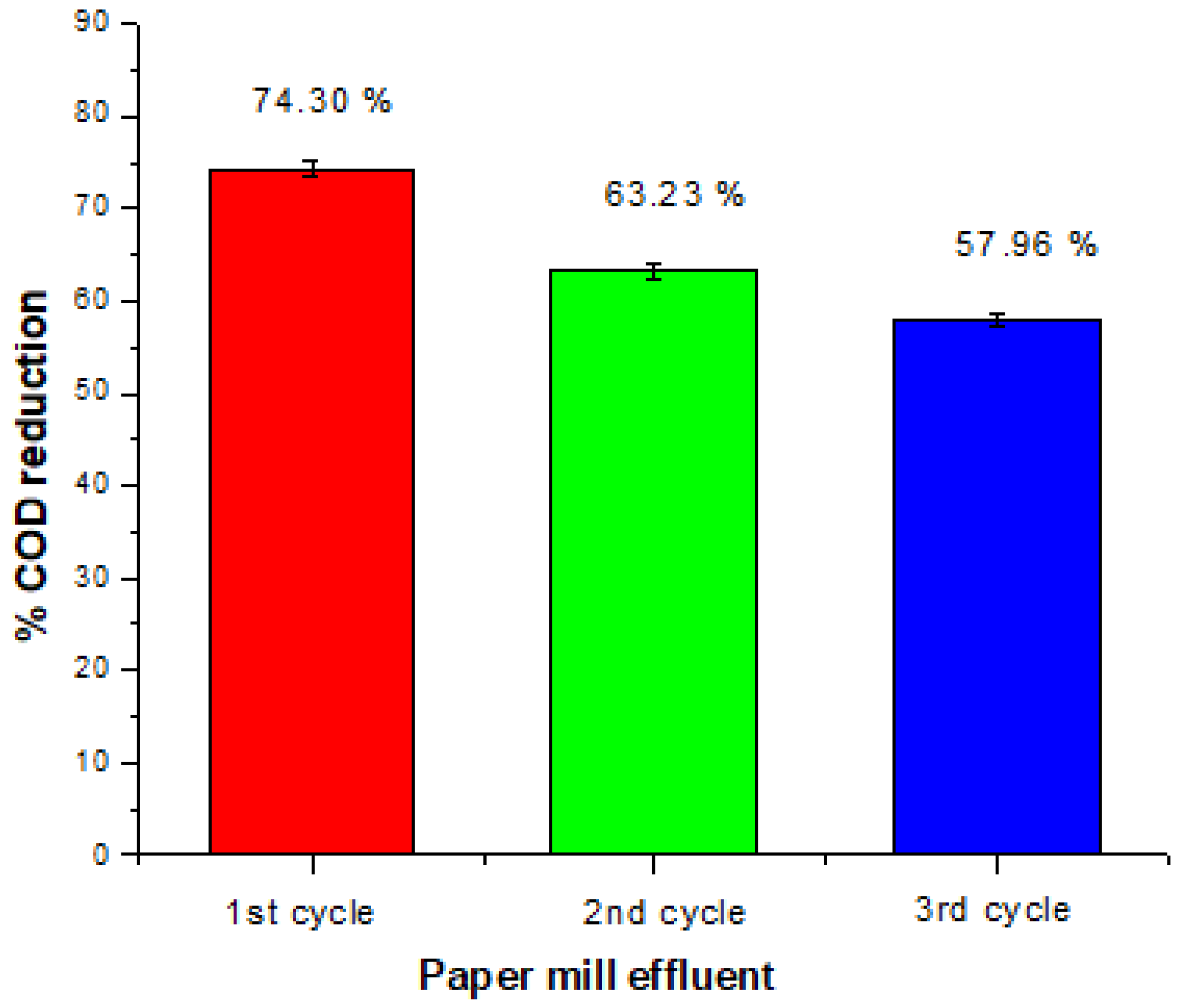
| Sample | A | C | c/a | Strain | Crystallite Size |
|---|---|---|---|---|---|
| ZnO | 3.2530 | 5.2130 | 1.079 | 0.44 | 33 |
| Compound | Space Group | a = b (Å) | c (Å) | α = β | γ | η = c/a | Cell Volume (Å) | Atom | x | Y | z |
|---|---|---|---|---|---|---|---|---|---|---|---|
| ZnO | P63mc | 3.22 | 5.2 | 90° | 120° | 1.6 | 47.5 | Zn | 0.333 | 0.6667 | 0.000 |
| O | 0.333 | 0.667 | 0.375 |
Publisher’s Note: MDPI stays neutral with regard to jurisdictional claims in published maps and institutional affiliations. |
© 2021 by the authors. Licensee MDPI, Basel, Switzerland. This article is an open access article distributed under the terms and conditions of the Creative Commons Attribution (CC BY) license (https://creativecommons.org/licenses/by/4.0/).
Share and Cite
Abbas, A.M.; Hammad, S.A.; Sallam, H.; Mahfouz, L.; Ahmed, M.K.; Abboudy, S.M.; Ahmed, A.E.; Alhag, S.K.; Taher, M.A.; Alrumman, S.A.; et al. Biosynthesis of Zinc Oxide Nanoparticles Using Leaf Extract of Prosopis juliflora as Potential Photocatalyst for the Treatment of Paper Mill Effluent. Appl. Sci. 2021, 11, 11394. https://doi.org/10.3390/app112311394
Abbas AM, Hammad SA, Sallam H, Mahfouz L, Ahmed MK, Abboudy SM, Ahmed AE, Alhag SK, Taher MA, Alrumman SA, et al. Biosynthesis of Zinc Oxide Nanoparticles Using Leaf Extract of Prosopis juliflora as Potential Photocatalyst for the Treatment of Paper Mill Effluent. Applied Sciences. 2021; 11(23):11394. https://doi.org/10.3390/app112311394
Chicago/Turabian StyleAbbas, Ahmed M., Sabah A. Hammad, Heba Sallam, Lamiaa Mahfouz, Mohamed K. Ahmed, Sayed M. Abboudy, Ahmed Ezzat Ahmed, Sadeq K. Alhag, Mostafa A. Taher, Sulaiman A. Alrumman, and et al. 2021. "Biosynthesis of Zinc Oxide Nanoparticles Using Leaf Extract of Prosopis juliflora as Potential Photocatalyst for the Treatment of Paper Mill Effluent" Applied Sciences 11, no. 23: 11394. https://doi.org/10.3390/app112311394
APA StyleAbbas, A. M., Hammad, S. A., Sallam, H., Mahfouz, L., Ahmed, M. K., Abboudy, S. M., Ahmed, A. E., Alhag, S. K., Taher, M. A., Alrumman, S. A., Alshehri, M. A., Soliman, W. S., Tabassum-Abbasi, & Mostafa, M. (2021). Biosynthesis of Zinc Oxide Nanoparticles Using Leaf Extract of Prosopis juliflora as Potential Photocatalyst for the Treatment of Paper Mill Effluent. Applied Sciences, 11(23), 11394. https://doi.org/10.3390/app112311394






